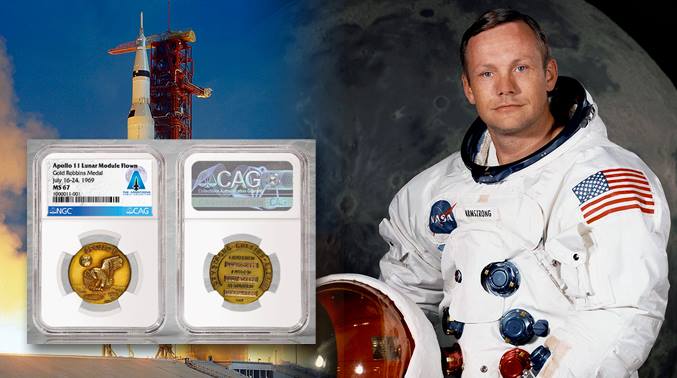From the First Walk on the Moon to the Auction Block.
In a little over a month, humanity will mark the 52nd anniversary of man’s, Neil Armstrong’s, first steps on the moon. On Jul. 20, 1969, at 10:56 p.m. EDT, Neil Armstrong plants the first human foot on another world. The situation was a little scarier than NASA had planned for. On approach to landing on the lunar surface, Commander Buzz Aldrin had to make some unexpected landing adjustments because of a computer error, and the lunar lander “Eagle” successfully landed on The Sea of Tranquility with only 30 seconds of fuel remaining. Fuel that the crew needed for their return to the orbiting command module Columbia which was being piloted by astronaut Michael Collins. Michael Collins eventually wrote an award-winning autobiography Carrying the Fire. A book I’ve read and consider one of my personal top 5 reads.
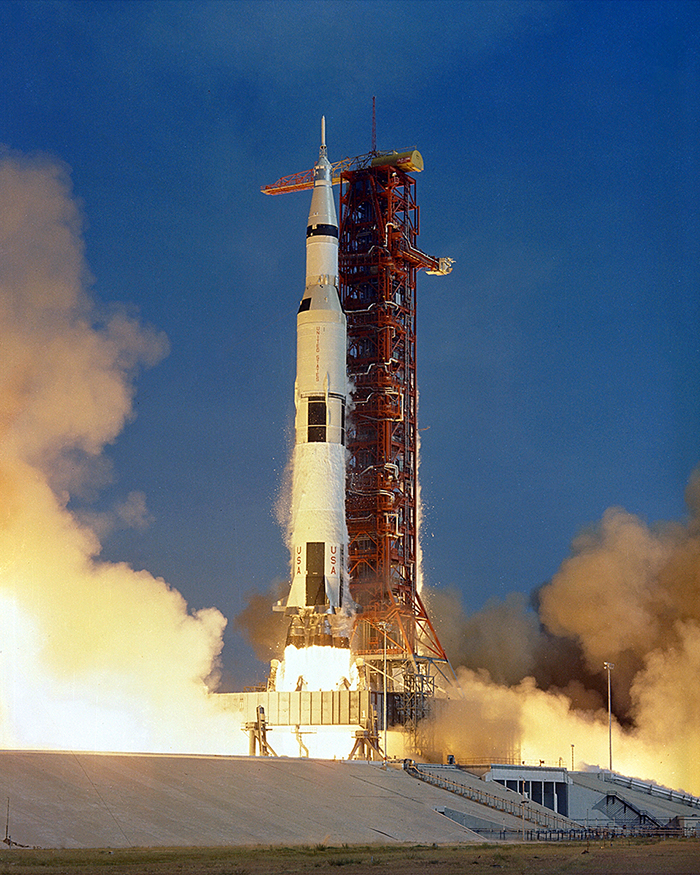
pilot Buzz Aldrin from Kennedy Space Center’s Launch Complex Pad 39A. Photo credit: NASA
As history has recorded, Aldrin and Armstrong did successfully make it back to Collins and the Columbia. After the Eagle successfully docked with Columbia, Collins, “for the first time,” “really felt that we were going to carry this thing off.” The crew successfully splashed down off the coast of Hawaii on July 24 which check-marked the bottom line of Apollo 11’s remarkable and historic lunar mission, arguably one of the single most historic events in modern human time.
In doing my research for this article, one word describing Neil Armstrong’s demeanor kept surfacing: modesty. Neil Armstrong, one of the more historically significant people in human history, was a very modest man who never sought fame, nor fortune, from his lifetime of hallmark accomplishments – and there were many. From piloting the record-breaking North American X-15 rocket plane, to walking on the moon, to serving as NASA’s Deputy Associate Administrator for aeronautics, Neil Armstrong did not waste his time here on terra firma (or luna firma).
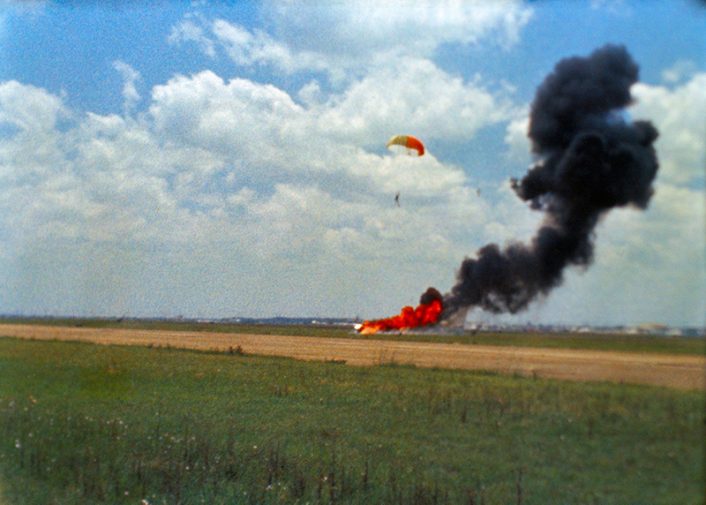
Fast forward to Aug. 7, 2012.
Neil Armstrong was admitted to Mercy Health Fairfield Hospital in Fairfield, OH for severe chest pains. On August 25 Armstrong died from complications resulting from “routine” coronary bypass surgery after a nurse removed two electrical connections to his artificial pace maker a week prior. He bled profusely into the membrane surrounding his heart. A lawsuit ensued and there was a $6 million settlement to the family. The end of a hero, the launch of a valuable legacy. Five years later, the auctions began.
Michael Riley is the Director of Space Exploration for Heritage Auctions in Dallas, Texas. Heritage Auctions was given the sole right to the Neil Armstrong estate artifacts (officially called The Armstrong Family Collection). Heritage Auctions, established in 1976, is one of the most formidable auction houses in the world. Out of curiosity, I did a Google Earth search on Heritage Auctions in Dallas, and their facility is massive. When speaking with Michael it was very obvious how proud he was that Neil Armstrong’s family had entrusted his company to disseminate these national treasures. Heritage began the Space Exploration division of their company in September, 2007. Joe Garino, who was a physical trainer for the astronauts at NASA, was the subject of their first Space Exploration auction. Many of the astronauts befriended Joe and they would bring him collectibles from their flights. The auctioning of Joe’s artifacts was the beginning of something big at Heritage Auctions.
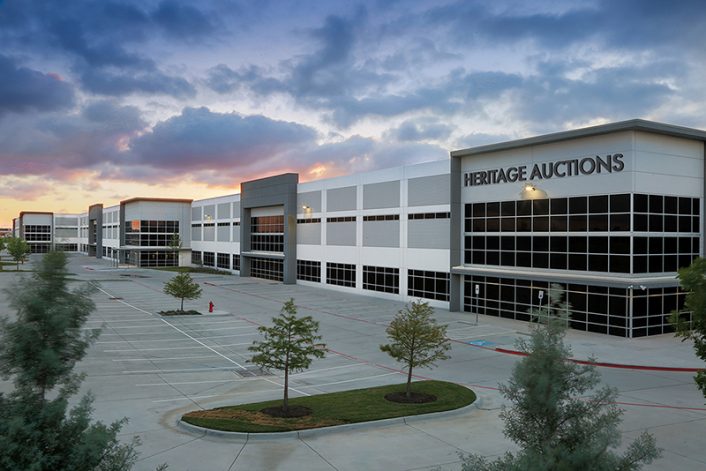
To date, the Armstrong Family Collection artifacts have netted the family more than $10,000,000 USD. There have been a total of six auctions with two more planned. I am truly impressed that Neil Armstrong had the foresight to bring with him on the Apollo 11 mission what he did. Fabric from the original Wright Flyer. Pieces of the original Wright Flyer’s propellers. A one-of-a-kind commemorative gold medal that ended-up selling for $2,055,000 USD. Michael provided me with these four links for the four top auctions for The Armstrong Family Collection™: link 1, link 2, link 3, link 4.
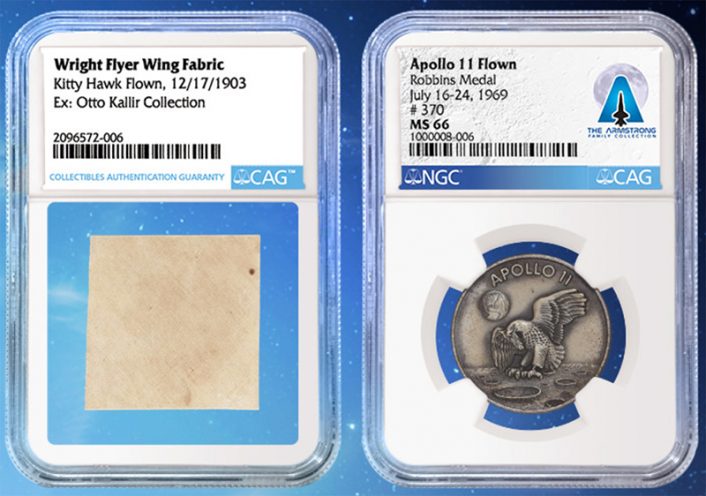
So, if you have an extra two million dollars taking-up space as dead weight, and you want to buy a one-of-a-kind truly historic NASA artifact, Heritage Auctions just, so happens, has one on the auction block. I can’t speak for my readers, but $2,000,000 is an unimaginable amount of money to me. I could buy a really nice P-51 with that kind of money. Instead, I decide to buy a gold medal that’s been to the moon on the mission that enabled man, humanity, to place a footprint on our first other world. That kind of decision is subjective, even questionable. You wrestle with it in your mind, but passion supersedes logical cognitive thought and you hit that “bid” button. You’re probably going through a whole gambit of emotions not unlike many of us have when we bid for something on eBay. How do you know what your bidding on is a safe bet for that spare change of yours?
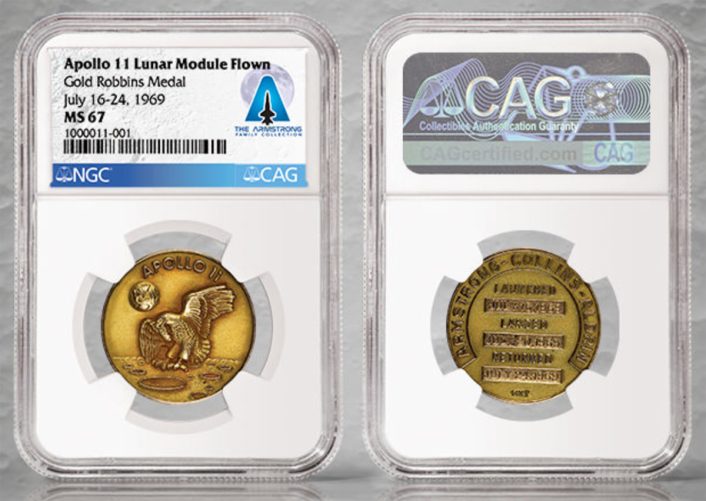
This is how we – and the world – know it’s real and your $2,000,000 investment is truly an investment. For the sake of documentation, I’m going to run through the acronyms: First, there’s the parent (company) acronym, CCG (Certified Collectibles Group). CCG is one of the world’s largest providers of expert, impartial and tech-enabled services that add value and liquidity to collectibles. The CCG companies include Numismatic Guaranty Corporation (NGC), Paper Money Guaranty (PMG), Certified Guaranty Company (CGC), Classic Collectible Services (CCS), Certified Sports Guaranty (CSG), Authenticated Stamp Guaranty (ASG) and Collectibles Authentication Guaranty (CAG). CAG is the company that certified the provenance of the Armstrong Family Collection artifacts. Since 1987, the CCG companies have certified more than 60 million coins, banknotes, comic books, trading cards, stamps, estate items and related collectibles totaling more than $40 billion (yes, that’s with a “b”). CCG has offices in the United States, United Kingdom, Germany and China.
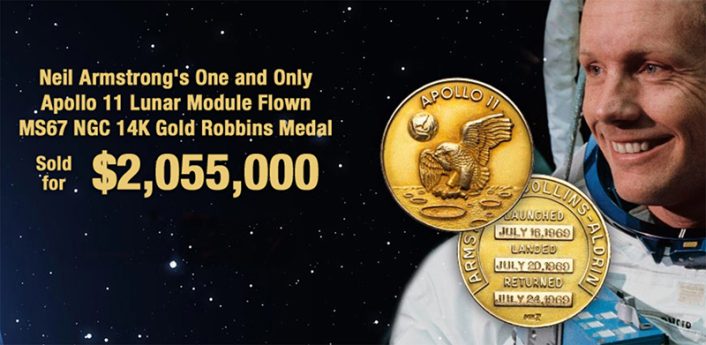
As life, and luck, would have it, my office is only about an hour’s drive away from CCG’s home office in Sarasota, FL. I sometimes get jealous of some of my colleagues like expert photographer Jim Mumaw and the extraordinarily talented Tom Demerly and their exposure to some amazing aviationry, because they are fortunate to be where really cool things fly over their heads. Me? Not so much (ordinarily). But I have a trump card on this one. I, figuratively, live a stone’s throw away from the single largest grading company in the world and I took advantage of it.
It was a sweltering day in South-Central Florida. My contact at CCG is Janell Armstrong who is their Marketing Coordinator. I can only describe my communications with this company as awesome. It’s a very serious company, with very serious (friendly) people doing very serious (but really fun) business. Back to the sweltering part. Janell arranged a visit to CCG at 3:00 PM on an exceptionally steamy Sarasota day. We arrived at a very professional-looking office complex guarded by a serious gate. Speaking as somebody with a significant law enforcement and security background, and as somebody who has visited some of the most secure installations in this country (both invited and…), I’ve got to say, those with ill intentions should pick another target.
Once we were on “the other side” of the security gauntlet we were met by Paul Sandler who is Director of Product Development for CCG. In an effort to avoid stereotyping somebody, I still have to acknowledge that Paul looks the part. Very intelligent, very enthused, and very excited about his company. He struck me as somebody with so much to say and so little time to say it. Paul gave us the tour of CCG and what a tour it was. Room after room (most very dimly lit) of machines, pallets of treasures beyond comprehension, and very determined and very dedicated workers. This place was surgically clean with an air of collector’s geekiness that I’ve never seen before. They have comic book artists actually physically go there to sign customers’ books to be graded.
There was an artist there while we were there but we never found out who it was. And there was a secret room. A room whose door would open quietly while the workers entered and exited. A room I didn’t even feel comfortable looking at. This was the room with the ancient artifacts. We were quickly hurried past this room. There were two white boards in the hallways where visiting comic book artists would draw their respective characters and sign the drawings. Paul stopped and looked at one of the boards, and shook his head like it was the first time he contemplated the actual collective value of the board. I think it overwhelmed him a little and he shook it off. We proceeded to the conference room.
The CCG conference room. Not a really big conference room, no windows. I think there might have even been a refrigerator in there. The conference table was a medium to dark colored wood, and was beautiful. The only thing prettier than the table were the very plush, butt-sinking-to-the-floor brown leather chairs that surrounded it. Those chairs were the perfect accompaniment to the comfort level I grew to feel during my visit. I was sitting at the helm of the company that certified, and gave credibility to, the two million dollar Neil Armstrong gold medal that went to the moon during humanity’s first physical visit there. These are the guys and gals who manifest credibility, and I was there.
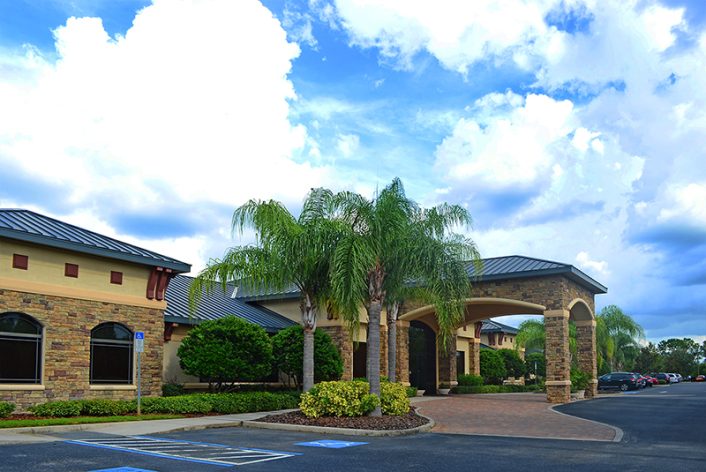
Max Spiegel is the President of CCG. In my life I’ve tried to picture myself doing different things. I’ve got a pretty decent imagination and picturing myself as a jet fighter pilot, or a state senator, or a bartender at a swanky bar doesn’t seem too far of a stretch. I can’t even logically tap into what it must be like to be president of a company who handles the world’s most valued artifacts. Max Spiegel struck me as being really young. Maybe I’m just really old, I don’t know. He came across as being very squared away, very hospitable, and super on top of things. Paul joined us in our meeting and, between the two of them, it was impossible to avoid their enthusiasm and love for their company. These were the men whose company single-handedly certified national treasures the likes of which will never be seen again. There may be a valid argument as to the commercialization of the Neil Armstrong artifacts. There is one indisputable fact: The physical evaluation and documentation of these precious national treasures, in itself, provided an invaluable service to this country, and to history itself.

